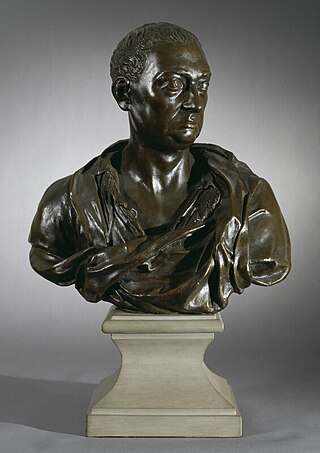This article needs additional citations for verification .(November 2012) |
| |||
|---|---|---|---|
| Buildings and structures +... |
The year 1730 in architecture involved some significant events.
This article needs additional citations for verification .(November 2012) |
| |||
|---|---|---|---|
| Buildings and structures +... |
The year 1730 in architecture involved some significant events.


1736 (MDCCXXXVI) was a leap year starting on Sunday of the Gregorian calendar and a leap year starting on Thursday of the Julian calendar, the 1736th year of the Common Era (CE) and Anno Domini (AD) designations, the 736th year of the 2nd millennium, the 36th year of the 18th century, and the 7th year of the 1730s decade. As of the start of 1736, the Gregorian calendar was 11 days ahead of the Julian calendar, which remained in localized use until 1923.

Nicholas Hawksmoor was an English architect. He was a leading figure of the English Baroque style of architecture in the late-seventeenth and early-eighteenth centuries. Hawksmoor worked alongside the principal architects of the time, Christopher Wren and John Vanbrugh, and contributed to the design of some of the most notable buildings of the period, including St Paul's Cathedral, Wren's City of London churches, Greenwich Hospital, Blenheim Palace and Castle Howard. Part of his work has been correctly attributed to him only relatively recently, and his influence has reached several poets and authors of the twentieth century.

Blenheim Palace is a country house in Woodstock, Oxfordshire, England. It is the seat of the Dukes of Marlborough. Originally called Blenheim Castle, it has been known as Blenheim Palace since the 19th century. One of England's largest houses, it was built between 1705 and 1722, and designated a UNESCO World Heritage Site in 1987.

Sir John Vanbrugh was an English architect, dramatist and herald, perhaps best known as the designer of Blenheim Palace and Castle Howard. He wrote two argumentative and outspoken Restoration comedies, The Relapse (1696) and The Provoked Wife (1697), which have become enduring stage favourites but originally occasioned much controversy. He was knighted in 1714.
John James was a British architect particularly associated with Twickenham in west London, where he rebuilt St Mary's Church and also built a house for James Johnson, Secretary of State for Scotland, later Orleans House and since demolished. Howard Colvin's assessment of him was that of "a competent architect, but he lacked inventive fancy, and his buildings are for the most part plain and unadventurous in design".

Baroque architecture is a highly decorative and theatrical style which appeared in Italy in the early 17th century and gradually spread across Europe. It was originally introduced by the Catholic Church, particularly by the Jesuits, as a means to combat the Reformation and the Protestant church with a new architecture that inspired surprise and awe. It reached its peak in the High Baroque (1625–1675), when it was used in churches and palaces in Italy, Spain, Portugal, France, Bavaria and Austria. In the Late Baroque period (1675–1750), it reached as far as Russia, the Ottoman Empire and the Spanish and Portuguese colonies in Latin America. In about 1730, an even more elaborately decorative variant called Rococo appeared and flourished in Central Europe.
The year 1891 in architecture involved some significant architectural events and new buildings.
Events concerning Architecture from the year 1736.
The year 1722 in architecture involved some significant events.
The year 1729 in architecture involved some significant events.
The year 1721 in architecture involved some significant events.
The year 1714 in architecture involved some significant events.

English Baroque is a term used to refer to modes of English architecture that paralleled Baroque architecture in continental Europe between the Great Fire of London (1666) and roughly 1720, when the flamboyant and dramatic qualities of Baroque art were abandoned in favour of the more chaste, rule-based Neo-classical forms espoused by the proponents of Palladianism.
The year 1742 in architecture involved some significant events.
The year 1760 in architecture involved some significant events.
The year 1716 in architecture involved some significant architectural events and new buildings.

Woodperry House is a Grade I listed building in Stanton St John, South Oxfordshire, England.

William Townesend of Oxford (1676–1739) was a 17th/ 18th century British sculptor, architect and builder associated with several important British buildings.